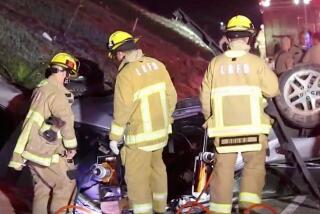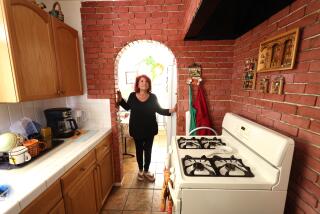Danger Is King of the Road : Stranded Freeway Drivers Find Themselves at Risk in No Man’s Land of Speed
- Share via
Chaibai Mustamandy was always afraid of the freeway, dreading all those speeding cars careening between lanes without notice. It was one reason the 57-year-old archeologist from Afghanistan never got his driver’s license.
He was even frightened of the road’s shoulder--the would-be respite from the freeway’s whooshing fury. Because bad things could happen. Even there .
On a hectic Friday night in early July, as he went to push his wife’s disabled car from the slow lane of the Simi Valley Freeway in Chatsworth, Mustamandy was struck by a passing car, his skull crushed as he was catapulted more than 50 feet.
“We left our homeland when the Russians invaded because we didn’t want the soldiers to kill us,” his wife, Mehria, said. “But the Russians didn’t kill my husband. The freeway killed him.”
It is a no man’s land, a snaking asphalt ribbon of speed and impatience, where heavy-metal trucks and automobiles hurtle like stampeding cattle. But it is only when motorists become stranded along the freeway’s slender shoulder that they come to know its stark loneliness, its nakedness. And its unique dangers.
Because there they are, suddenly enduring their private predicament in a public place--a fishbowl world where peering faces whiz past behind car windows but do not stop. And in a teeming, sometimes lawless city such as Los Angeles, they know they must be leery of those who do.
“It’s one of the most dangerous places in the world,” said California Highway Patrol spokesman Glen Dominguez. “You’ve got no place to go. And you can’t always trust the people who stop to offer help. Sometimes I don’t think the good Samaritan lives in this city anymore.”
There are 511 miles of freeways crisscrossing Los Angeles County. Each month, according to the Metropolitan Transportation Authority, CHP dispatchers answer an average of 40,000 emergency calls from 4,000 toll-free call boxes.
That’s about 1,300 calls a day. Fifty calls an hour. One a minute.
Still, scores of pedestrians are killed each year on county freeways--many of them stranded motorists and transients waging an ill-advised freeway crossing gamble.
On the freeway sidelines, the unexpected becomes commonplace. Weirdness prevails.
Babies have been delivered by harried highway patrolmen and fathers in shock. Men have suffered heart attacks. Small planes have crash-landed. Addicts have shot up heroin in the back seat of their car. Sitting lotus-position, a woman stopped in the fast lane of the Ventura Freeway for her morning meditation, explaining to officers: “I always meditate at exactly 10:30.”
And talk about messy spills. On any day, the traffic lanes, medians and shoulders have been bombarded by lost loads of frozen chickens, nails, toxic waste, fire hydrants, refrigerators. Even bodies.
It’s a place of quick and sometimes foolish decision-making: A woman once pulled over during the middle of rush hour for an afternoon catnap. Panicked motorists have been struck as they raced across traffic lanes to a call box.
Recently, a transient was struck in the fast lane of the Golden State Freeway as he searched for his lost dog near downtown Los Angeles. And a vacationer was killed as he sidestepped through traffic to retrieve a suitcase that had blown off the top of his car.
But on the road, it’s not just speed that can be deadly. Crime plays a role as well.
Freeway shoulders throughout Southern California have been the scene of murders, rapes and armed robberies, as well as carjackings, soured drug deals, thefts and burglaries.
In February, an Oxnard housekeeper was sexually assaulted at knifepoint by a man who stopped to offer assistance after her car broke down on the Ventura Freeway in Camarillo. Last fall, a naked man tried to rape a woman who was trapped in her car along a freeway in Bellflower.
In the late 1980s, there was a wave of shootings on Los Angeles freeways as frustrated motorists took their anger out on one another.
In Orange County, one man was shot to death in 1990 when gunmen in two vehicles pulled to a shoulder in Anaheim before jumping out to exchange gunfire.
Images of freeway fear and loathing have seeped into film treatment as well as newspaper headlines beyond California.
In the 1990 movie “Henry: Portrait of a Serial Killer,” a mass murderer stops to approach a stranded motorist in a Chicago freeway tunnel--not to help, but to kill.
Curtiss Perry knows all too well the dangers of the road shoulder.
In March after arresting a suspected drunk driver, the 29-year-old CHP officer was struck down on a well-traveled highway near the Salton Sea by a motorist who fell asleep at the wheel.
Perry, who had both legs amputated above the knee after being crushed against the back bumper of his patrol cruiser, has retired.
“So many people think that being broken down on the freeway is like any old residential road, and it’s not,” he said. “Most people whizzing by aren’t paying attention--they’re looky-loos gazing smugly at your luck, thinking: ‘There but for the grace of God go I.’ ”
Indeed, experts say, most freeway motorists don’t realize the speeds at which they’re traveling.
“If a driver is traveling 60 m.p.h. and turns away from the wheel for just five seconds--long enough to say something to a person in the back seat--he’s traveled a full football field and a half. Literally, his car is a ship without a captain,” said Peter O’Rourke, director of the state Office of Traffic Safety.
“Statistically, the automobile is the most dangerous form of transportation we have,” O’Rourke said. “And leaving your car on the freeway greatly increases the danger.”
The portent of freeway danger is changing Californians’ driving habits: Cellular phone industry officials say women are buying in greater numbers as a precaution.
A 1993 survey showed that 70% of cellular phone owners nationwide believed that safety was the best reason to have one. Half said they had used their phones to report motorists with car troubles, medical emergencies, crime or suspected drunk drivers, according to the Cellular Telephone Industry Assn. in Washington.
Although car cellular phone sales have risen in recent years, their overall use has declined.
“Now more than ever, people are now buying these phones for safety, and no longer just to call the boss,” said Melissa May, a spokeswoman for PacTel Cellular.
*
Surely, the good Samaritan makes frequent visits to the freeways of Southern California, CHP officers say.
In fact, one of their own was assisted recently by a female motorist who used the patrolman’s radio to summon help while he wrestled with a suspect on the shoulder of a road near Bakersfield.
Still, when faced with such decisions, most freeway motorists face a quandry: To stop or not to stop?
Psychologists say the act of offering assistance--especially on the freeway--requires most people to first answer one question: What’s it going to cost me?
“Freeway drivers realize offering help requires pulling over and getting out of traffic without getting yourself killed,” said Norman Miller, a psychology professor at USC. “And many people feel it’s just not worth it.”
Especially during rush hour, drivers figure there are always other, more-qualified drivers to help a motorist in need. Or they dismiss the person as irresponsible: “Why didn’t they buy enough gas?” they might ask.
“The irony,” said Stephen Read, another USC psychology professor, “is that the more people there are around who could help, the less likely it is that any individual will help.
“Cars isolate us. They create this emotional distance. People say: ‘The CHP will be by to help. Or a tow truck.’ In the end, sometimes no one stops.”
Research suggests that motorists are more likely to offer roadside assistance in small towns rather than in the more anonymous big city. Another study showed that more motorists would become good Samaritans if prompted by another roadside volunteer.
“The study planted someone helping a distressed motorist fix a flat tire and then set up another needy driver two miles down the road,” said Bernard Weiner, a UCLA psychologist. “When motorists saw others helping, it activated such thoughts within themselves.”
Perry, the disabled CHP officer, has advice for freeway motorists: “People think they’re safe just because their doors are locked and they’re cruising happily along. But remember, it’s a false feeling of safety. Your car could break down at any minute. It could be something as simple as a flat tire or broken belt.
“And then where are you?”
*
Floyd Bolton Jr. is a road warrior.
Eight hours a day, when motorists need him most--during morning and evening rush hours--he and 137 other tow truck drivers for the county freeway service patrol hit the road in search of breakdown victims.
They provide a free roadside service, dispensing gas and antifreeze, fixing flats. Or they take drivers and their vehicles to a safe drop-off point.
For Bolton, it helps in two ways: The disabled are escorted off the dangerous freeway while traffic flow is kept at a bearable flow.
Each day, Bolton and his gang of tow truckers help more than 1,000 motorists stranded throughout Los Angeles County.
Out of every 100 cars he assists, 31 have mechanical problems, 15 just need enough gas to drive to the nearest service station, 11 have overheated, eight have flat tires, four have been in accidents; the rest are miscellaneous calls. One in three cars needs to be towed; the rest are up-and-at-’em after a pit stop.
Like uniformed patrolmen, the 33-year-old Bolton works a beat near downtown Los Angeles, covering sections of the Harbor and Hollywood freeways.
On the road--driving, always driving--he’s seen it all: Motorists who have returned from a freeway call box to find their disabled vehicles stripped of their stereos and trunk contents.
Bolton has approached female motorists who refuse to roll down their windows to accept his help. “I don’t blame them,” he says of female drivers. “And until I can prove who I am. .”
*
A stranger came to Chaibai Mustamandy in his painful, final hours.
He lay near death on the asphalt. Against his wife’s advice, he had jumped out to push their stalled car off the Simi Valley Freeway.
Sitting in the driver’s seat, Mehria Mustamandy recalled seeing a pink balloon sail by her window. But it was her husband, dressed in his pink party shirt--thrown from the impact of a passing car.
Almost instantly, a motorist appeared and placed a sweat shirt under his head, asking him questions, trying to him keep conscious.
But even Chaibai knew it was too late.
“He pulled me close to him,” Mehria said, “called me by that little name he always called me, and then he said, ‘I love you. I think I’m gone. I love you. And I love the children.’ ”
Chaibai, a Santa Monica resident and noted scholar and lecturer due to return to his homeland in August on an archeological expedition, died hours later.
His wife never met the woman who stopped to help--nor does she know the name of the driver who struck and killed her husband.
“I never want to see their face,” she said. “And I never, ever want to go back to that terrible spot, the place where the freeway took my husband.
“And I never will.”
Freeway Safety
Freeways do not have to be dangerous places. Here are some tips from the California Highway Patrol.
*
If stalled along side freeway
1. When your vehicle comes to rest, turn your wheels straight ahead.
2. Place the car in “park.”
3. Exit on the passenger side away from traffic to use a call box.
4. When using a call box, face traffic to watch for oncoming vehicles. The operator will phone your automobile club, a family member, friend or insurance company for emergency assistance.
5. It may be safer to remain near the call box or behind a guardrail.
6. the person coming to your aid should park at least 100 feet in front of your vehicles to allow room tor the tow truck. Never stand between the two vehicles. When the tow truck arrives, wait inside it.
*
If your car stalls in a traffic lane:
1. Turn on your emergency flashers immediately.
2. Remain inside your car with your seat belt fastened while you wait. Your may be rear-ended by another driver, but your car offers at least some protection.
3. If your engine quits, try to steer your vehicle to the road shoulder.
4. If the vehicle runs out of gas, put it in neutral, signal, and try to coast to the side.
5. After a crash, don’t block traffic lanes to exchange information with the other driver. If possible, pull immediately to the side of the road.
6. Remain calm in any freeway emergency. The chances for injury increase when you stop thinking about your next move.
More to Read
Sign up for Essential California
The most important California stories and recommendations in your inbox every morning.
You may occasionally receive promotional content from the Los Angeles Times.











